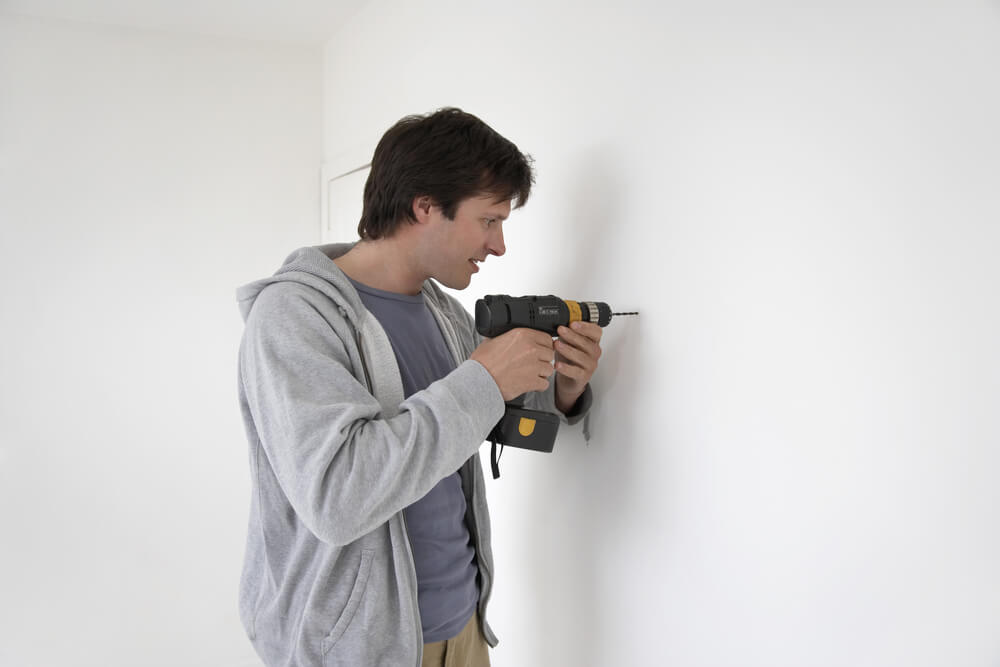Swinging in a hammock is a relaxing experience and a fantastic way to catch some shut-eye. Although hammocks usually hang outdoors between two trees, this is not always the case.
If you enjoy kicking back in a hammock, you don't have to relegate yourself to hanging one outdoors only. You can certainly set up a hammock indoors as well.
The only caveat is that other hanging methods are necessary, as you won't have two trees to help you.
One issue you are sure to encounter is drilling. Lots of indoor hammock installations require a power drill to complete.
Fortunately, drilling holes in walls, ceilings, or other fixtures to hang a hammock isn’t always necessary. You can feasibly hang a hammock indoors without any drilling whatsoever.

Table of Contents
How to Hang a Hammock Indoors Without Drilling
Installing a hammock can be done indoors without any drilling. However, you will need to embrace some innovative options.
Complete Indoor Hammock Kits
If you want to hang a hammock inside your home without drilling, the easiest way is to purchase an indoor hammock kit that has a stand. Be mindful that a hammock that comes with a frame will be more expensive. However, they also have the bonus of not requiring any work when it comes to hanging.
After purchasing the hammock, assemble the included stand according to the instructions and simply hang your hammock on it. This option will most certainly be the easiest way to install your hammock indoors without power tools of any kind.
Although hammock stands take up considerable space, most of them will accommodate almost all hammocks, and they can get moved from place to place without much effort.
Using Roof Beams
Another viable option for hanging a hammock indoors without drilling is to use the beams that already exist in your roof or ceiling. You will use your hammock straps to hang your hammock; no drill is necessary.
Before using your ceiling rafters or roof beams to hang a hammock, you must make sure that they're in good condition and capable of holding the weight.
You might run into an issue where the roof beams don't have proper spacing. The spacing is crucial because you don't want the hammock hanging too tightly or too loosely.
On the bright side, apart from a hammock straps kit and a hammock itself, you won't need any other equipment or tools. Just use the existing structures to hang your hammock, and the chances are that it can support a lot of weight.
When hanging your hammock using this method, choose the correct rafters or beams and best location and install the straps as you would outdoors on a tree. The main difference is that you're installing it on a horizontal beam instead of a vertical tree.
At this point, take the hanging strap and wrap it around the rafter or beam. Next, feed one end through the hole in the other end. After doing this, use carabiners or S-hooks to attach your hammock. Do this step for both sides.
Thanks to the two straps attached to the beam, you should have an easier time hanging your hammock indoors!
Posts or Vertical Beams
You can also try using the existing posts or vertical beams in your house. This option won't be possible if your home isn't already structured this way, but if so, this could work well.
You'll need to make sure the posts have adequate space between them for the length of the hammock. If there's enough space, try this method to get the hammock in there right away.
A hammock kit should be sufficient to get the job done in this case, as it was with the ceiling rafters. A tree strapping kit should have all the pieces you'll need, seeing as how the posts or beams in your home are similar to tree trunks.
You want to keep in mind that the texture of the beams is different from that of tree trunks. Trees have a lot of texture and they're rough to the touch. The beams or posts are likely too smooth, so the hammock straps could slip if you don't secure them correctly.
Make sure you wrap the straps as tightly as possible to guarantee that the hammock doesn't crash to the ground under your body weight.
It's worth considering making an incision in the posts at the height where you will install the hammock. This way, the straps will fall into the grooves and remain there instead of sliding down.
Just like with the rafters, you want to wrap the straps around the posts or beams and tie them. Next, you need to insert the carabineers or the S-hooks into the loops. Firmly attach your hammock and be sure everything is in the right place and feels secure.
Why You Can’t Drill?
There might be numerous reasons as to why you can't drill in your home to hang a hammock or why you just don't want to go that route, including:
- You don't know how to drill
- You don't have the necessary tools to drill and you don't want to make the purchase
- You cannot make any renovations or changes to the structure because it's a rental
- Asbestos is present in the walls, and it is not safe to drill
- There is not the proper amount of space between the studs in the walls
Final Thoughts
Most times, when we think about hammocks, relaxation comes to mind. Not only is it a cool feature to add to your home decor, but it's comfy as well.
Despite the reasons you do not want to drill, you can still figure out how to hang a hammock indoors without drilling in your home, at least if you have one of the options mentioned above.
The only concern you have to keep in mind is that your hammock needs to support your body weight. Aside from that, if you secure all of the hammock’s pieces correctly, you shouldn't have any problems with the installation.
Good luck!
- Are Merrell Shoes Good? – An Unbiased Review of Merrell Footwear - December 9, 2023
- Where Are Merrell Shoes Made? - December 9, 2023
- Camping in 40-degree Weather: Tips and Tricks - September 25, 2023


![How to Hang a Hammock on a Balcony? [Step-by-Step Guide] How to Hang a Hammock on a Balcony? [Step-by-Step Guide]](https://grandcircletrails.com/wp-content/uploads/2021/09/hammock-on-the-balcony-1-150x150.jpg)

![3 Ways to Hang a Hammock in Your Apartment [Must-Read] 3 Ways to Hang a Hammock in Your Apartment [Must-Read]](https://grandcircletrails.com/wp-content/uploads/2021/09/Can-You-Hang-a-Hammock-in-an-Apartment-1-150x150.jpg)

![How to Put Out a Fire without Water? [Guide] How to Put Out a Fire without Water? [Guide]](https://grandcircletrails.com/wp-content/uploads/2022/03/How-to-Put-Out-a-Fire-without-Water-2-150x150.jpg)